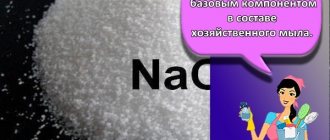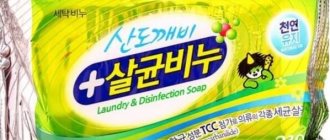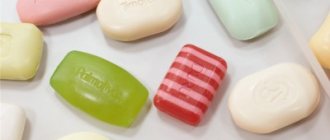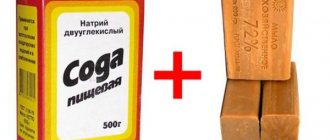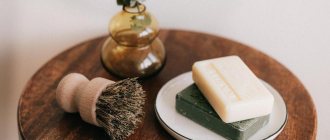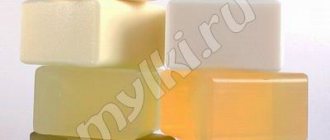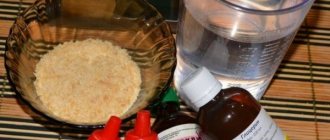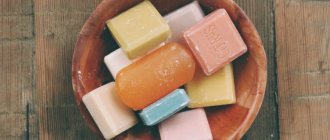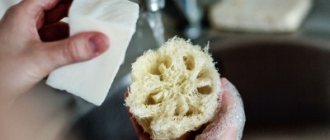Modern household chemicals can cope not only with any contaminants, but also cause certain harm to the human body. Increasingly, people are complaining of allergic reactions as a result of using one or another household chemical. We are especially talking about the use of such products in apartments where small children live. Many modern mothers are faced with the fact that their babies suffer during contact with those surfaces that were previously treated with household chemicals. In such situations, when you need to keep the apartment clean and at the same time worry about the health of your child, many mothers have come up with an excellent option that ideally combines these two points. In this case, we are talking about cleaning using only natural products, in particular laundry soap. Some women even manage to make this product themselves. After reading this article, you will learn the simplest options for making laundry soap.
Benefits of making laundry soap at home
The first and most important advantage is the complete naturalness of the finished product. Thanks to its unique properties, this product can cope with almost any stain. Another advantage of this product is its low cost. In other words, to prepare it you will need simple improvised means that are found in any home. In addition, the prepared portion lasts for a long time.
How to make laundry soap
You should think in advance about what the soap will be used for. The amount of additional oil in the recipe - the so-called superfat - depends on this.
It is assumed that all oils in the mixture must react with caustic soda (saponification will occur). But in practice, even oils of the same type have different characteristics. So-called soap calculators, used to calculate recipes, use average values for a specific type of oil.
Therefore, there is no guarantee that oil added to the mixture strictly according to the recipe (with 0% superfat) will completely bind the alkali. The resulting soap is ideal for machine washing, since it will not form a film on the walls of the tank. But hand washing or washing dishes with such soap can only be done with rubber gloves: it dries the skin, and even corrodes in particularly sensitive people.
To avoid inconvenience, 1–3% superfat is added to soap. There is no need to calculate the additional amount of oil yourself: just set the percentage of excess fat, and when calculating the proportions, the calculator will automatically subtract the excess. For example, if you need to calculate the amount of alkali to saponify 1 kg of butter with 1% superfat, the calculator will give the result for 990 g of butter. But soap with too much superfat can leave a film on the walls of the washing machine.
Be sure to measure all ingredients on an electronic scale. Every gram counts. To mix the ingredients, use a bowl with a slightly larger volume than required, otherwise the liquid will splash out when whipping. The temperature of all ingredients should be approximately the same. Temperature differences of no more than 10 °C are allowed.
Preliminary preparation for the soap production process
To make high-quality laundry soap with your own hands, you will need to prepare all the ingredients in advance. During the cooking process, be sure to follow safety precautions. The whole point is that you will be working directly with alkali, and this carries a certain degree of danger. To protect yourself from various injuries, be sure to wear household gloves. It is advisable to wear a respirator, so you will not come into contact with the fumes that will be released during the cooking process. You can also put on an old robe so as not to stain your clothes with soap particles.
To ultimately get one and a half kilograms of soap, you will need to take a certain amount of ingredients. So, you need to prepare 400 milliliters of cold water, 150 grams of caustic soda. You will also need one liter of sunflower oil.
Safety regulations
Laundry soap contains caustic soda, which should be handled with extreme caution. Necessary:
- remove children and pets from the premises;
- clear the work surface: nothing should interfere with the movements of the soap maker;
- Prepare clean and dry dishes, soap molds, and a water thermometer. Neither the dishes nor the molds can then be used for cooking. Silicone containers or even cardboard milk and juice bags cut lengthwise are suitable as forms;
- turn on the hood or open a window;
- All operations should be carried out wearing glasses and a respirator (medical bandage), since alkali vapor is extremely dangerous for the mucous membrane;
- wear work clothes with long sleeves and high gloves made of thick rubber. If a soap solution splashes onto an open area of skin, it should be immediately rinsed with acidified water, and then with a large amount of running water.
The simplest technology for making laundry soap
The technology for making laundry soap from scratch is not that complicated. First of all, you need to carefully pour the baking soda into the water and start stirring gradually. As soon as you start cooking, be sure to turn on the hood and open all the windows so that there is as little fumes in the room as possible. Stir the soda with a wooden stick until it is completely dissolved. Then begin to carefully pour the soda solution into the preheated oil. Do not pour the sediment with undissolved soda into the oil. It needs to be extinguished with vinegar or citric acid.
Stir until thickened
Start stirring the solution slowly, after a while you will begin to notice that the liquid will begin to turn white and thicken. As soon as you see these changes, immediately connect the mixer and use it to cook. If you choose this recipe, then at the end the prepared mass should resemble thick sour cream.
Soap mold
Begin to carefully pour the prepared mixture into the molds. The next day the soap will have thickened, you must take it out and put it on a tray so that it fully matures within 3 weeks.
When making laundry soap from scratch, you should give preference to inexpensive oils, since the soap is consumed quite quickly and will be used mainly for washing dishes and preparing laundry gel.
In this recipe, the main oil will be sunflower (80%), with a small addition of castor (10%) and coconut (10%) oils. Of course, if you wish, you can also use olive oil, depending on who you like.
The soap will be prepared using a hot method. Per 1 kg you will need: - sunflower oil - 800 g - castor oil - 100 g - coconut oil - 100 g Alkali - 137.58 g. Water – 330 gr. (the percentage of water to oil in the calculator is set to 33%). SF (superfat 2%) - 1% is set in the calculator (safety, so to speak) and 1% after readiness in the sauna. (Superfat to be added after the bath is calculated based on the weight of the oils in the recipe) Superfat after the bath is 10 grams of castor oil. Since the soap will be intended for household needs, the excess fat is minimal.
So, let's start making laundry soap from scratch . If this is your first soap-making experience, then you should read the article What you need to make soap from scratch. After the preparatory stage (preparing everything necessary and putting on protective equipment), you need to measure out the oils according to their weight in the recipe.
It's best to start with the only solid oil in the recipe - coconut.
It must be melted in a water bath. When the coconut oil melts,
you will need to add castor and sunflower oil to it. Then you need to measure the required amount of lye and water (instead of water for laundry soap from scratch, you can take a strong coffee decoction). (Before starting to work with alkali, you should already be wearing a mask, gloves, and a respirator). Everything is clear with water - we poured it, weighed it and everything was ok. Lye is a little more difficult. For weighing, it is better to use disposable plastic cups so that you can throw them away immediately. We measure the lye carefully, pouring it with a spoon from the container where it is stored, and not over the edge.
Next you need to prepare an alkaline solution. It is best to do this in the sink. The water must be pre-cooled. Pour the lye into the water in small portions with continuous stirring. You should remember about safety precautions and be careful - you need to pour the alkali into the water and not vice versa. When the alkali dissolves in water, the solution will need to be filtered. When the alkaline solution is ready, it must be mixed with oil. Here it is necessary to take into account the temperature of the solution and oils - it should be almost the same and differ by no more than 1-2 degrees. If there are a lot of solid oils in the recipe, then when melted in a water bath they naturally heat up, and when liquid oils are added to them, the temperature often becomes optimal. (In general, the temperature range for mixing oil and alkaline solution is 30-70 degrees). In our case, there were few solid oils and the oil remained cold, which means it will need to be heated. The optimal temperature for mixing is 40-45 degrees. We measured the temperature of the oil, measured the temperature of the lye solution, and when they were equal, we could start mixing.
Pour the alkaline solution into the oils in a thin stream, stirring constantly. The oil will immediately become cloudy. When all the solution has been poured in, you need to put the spoon aside and use a blender for further mixing.
(You can, of course, use a blender and stir with a spoon until a trace is achieved, but this process can take a very long time). In order not to overheat the blender, you should stir at intervals, for example, stir for a minute with a spoon, for a minute with a blender, and so on until the trace occurs. By trace we mean such a state of the soap mass when it no longer flows from the blender (spoon), but stays on it, and traces from the blender remain on the surface. Since there are no plans to make swirls, you should not catch a light, just beginning trace, but it is better to wait for a solid and obvious one. Especially for those for whom making laundry soap from scratch is their first experience in creating soap from scratch. When the trail stage is reached
transfer the soap mass into a saucepan, cover with a lid and place in a water bath, where it will remain for the next 3-4 hours, since this laundry soap will be prepared from scratch using a hot method.
The pan with the soap mass and the pan for the water bath should be selected so that the water reaches the level of the soap mass, and not below. After 20-30 minutes (sometimes earlier, sometimes later), the soap mass begins to enter the gel stage - sections of the mass change color and become more transparent.
Or here’s another photo from another batch of soap, for clarity:
- almost the entire mass has already entered the gel.
When the whole mass has entered the gel, you will need to mix it thoroughly and leave it in the bathhouse (under a closed lid).
And then depending on the situation - if a crust forms on the surface, then you will need to stir the soap mass every 20-30 minutes, but if not, then less often. In general, there is no need to get involved in the masses unless necessary - let it cook for itself. It is worth noting that all manipulations with the soap mass before it is ready must be done with gloves, because burns from such a soap mass can be the same as from a pure alkaline solution. After 2.5-3 hours, you can check the soap mass with ph strips or a ph meter (the latter, however, although the most accurate, is very expensive). The pH of finished soap from scratch is around 8.5-10. If more, then let the mass remain in the bathhouse further. When the ph strips show that the soap is ready, to be sure and have peace of mind, you can also conduct a “language test” to determine if the soap is ready. How it's done. A small piece of soap mass should be stretched between your fingers and lightly touched with the tip of your tongue. If the soap is not ready yet (not all the lye has reacted), then the tongue will feel like a prick of needles. If this happens, you should immediately rinse your mouth with water several times. If the tongue feels only a soapy taste, then the soap is ready. For those who suddenly do not know, it is not very beneficial for health and you should not resort to it very often, and if possible, it is better to refuse it altogether.
So, when the soap mass has been prepared in the bathhouse, you need to add superfat - 10 grams of castor oil (the oil was chosen arbitrarily, you can take any other), mix thoroughly and place in a pre-prepared form. And the mold should first be lined with baking paper or plastic wrap so that you can easily get the soap out. They put it in a mold, covered it with a napkin and put it away somewhere to harden for a couple of days. Usually a day is enough, but this laundry soap is made from scratch from almost nothing but liquid oils, so it will take much longer to harden. When the soap has finally hardened, you can remove it from the mold and cut it into portions. The soap will still be soft and it is better to let it dry for a while, but you can use it right away.
Here's the result:
In general, the impressions of such laundry soap from scratch are positive. Foams very well - voluminous and airy foam. Cleans dishes perfectly. It was even used instead of shampoo - also excellent: the hair was well washed, light and voluminous. The only downside is that it went rancid quite quickly (acquired the smell of rancid vegetable oil) - after 3 months, but, however, did not lose its properties due to this.
Another possible option is laundry soap with the addition of ground coffee:
This soap is made using the cold process. You shouldn't expect this soap to smell strongly of coffee, but the slight coffee aroma remains.
Features of liquid laundry soap
Many modern housewives claim that liquid laundry soap is much better than a solid base. To prepare it, you will need to take 100 grams of ordinary laundry soap, 20 grams of water, a teaspoon of corn starch and potassium hydroxide. Initially, you will need to thoroughly grind the soap on a plate, add warm water and place in a water bath. Within 20 minutes the soap mass will become transparent. To speed up this process, you can add a little sugar to the mixture. After this, remove the solution and leave it for about twenty minutes so that it cools completely. Then add potassium hydroxide, thanks to which the soap will always be in a liquid state in the future. Then add cornstarch and mix everything thoroughly.
In conclusion, it should be said that laundry soap is a unique product that can be used for a variety of purposes. Very often they are even recommended to wash dishes, since conventional means are harmful to the human body, in the case when soap simply gets rid of dirt and does not pose any danger.
You might be interested in
- Is it possible to wash dishes with laundry soap - expert opinions
- What is the difference between laundry soap: dark, light, 72%, 70%, 65%
- General cleaning of the apartment: where to start?
Useful properties of laundry soap
Surely your grandmothers still reject modern household chemicals and prefer to clean the house, wash and wash only with proven laundry soap. This product, in addition to its ability to wash the most difficult stains, including oil paints and fuel oil, is an unsurpassed antimicrobial agent? Such soap will be a worthy competitor to many pharmaceutical preparations, the action of which is aimed at destroying pathogenic flora.
Benefits of the brown bar:
- soap foam is ideal for washing eggs, fruits and vegetables;
- For hygiene purposes, hair combs and toothbrushes can be treated with soap;
- The product whitens laundry perfectly, is safe for washing clothes for newborns and cleans dishes well from greasy deposits.
Laundry soap in folk medicine:
- for the flu - soap foam is used to treat the inside of the nostrils, removes runny nose and nasal congestion;
- from fungus, papillomas, purulent wounds - soap foam is also used here to lubricate the affected areas;
- chemical and sunburns - wounds are treated with foam until the skin is completely regenerated;
- acne and rashes - to clean your face, you need to regularly wash your face with laundry soap;
- seborrhea and dandruff - to eliminate them, it is recommended to wash your hair with soap, followed by rinsing your hair with a vinegar solution or water with lemon juice;
- gynecology - this product is effective against thrush, as it has antifungal and anti-inflammatory properties (used for washing).
Preparation of caustic soda
When mastering the basics of soap making at home, it is important to learn how to prepare caustic soda.
Caustic soda can be obtained from soda ash or crystalline soda and slaked lime. For 1 kg of soda ash or 2.85 kg of crystalline soda you need to take 900 g of slaked lime.
- All work on the preparation of caustic soda and “milk of lime” should be carried out only in the fresh air! Work clothes: long-legged trousers and a long-sleeved shirt made of special fabric, safety glasses, canvas gloves with gauntlets, a construction mask!
The container for making caustic soda, necessary for making soap with your own hands, is selected so that after adding all the components, it is filled only 2/3 of the volume.
Heat 4.5-4.6 liters of water to 30°C and add 1 kg of soda (or 2.85 kg) and stir thoroughly. The result will be a solution with a strength of - 23°B (increasing the content of caustic soda in the solution (more than 23.2°B) leads to the loss of soda, lowering the concentration of soda in the initial solution increases the degree of caustication9, however, this increases the amount of water and delays the process of obtaining a more concentrated caustic soda, therefore, 23°B is the best option). Bring the solution to 60°C and start pouring in small portions “milk of lime” (1:2), or better yet, powdered slaked lime.
- The solution begins to foam strongly and can overflow due to the rapid release of carbon dioxide and a large amount of heat (exothermic reaction). Therefore, it is necessary to constantly stir the contents vigorously throughout the cooking process.
The more thoroughly the liquid is mixed, the better the process of converting soda ash into caustic soda, i.e. caustic soda.
The mixture must be kept for 40-60 minutes at a temperature close to 100°C. Remove the container from the heat and let it sit. Prepare a clean container for draining the caustic soda, weigh it and drain the clear liquid from the sediment.
The container with the solution is weighed and the net is subtracted. The weight of the caustic soda solution should be 3.9 kg, with a strength of 20-21°B when adding lime powder and 13.8°B when adding lime milk, while the weight of the solution will be -5.5 kg. Some of the undissolved lime, chalk and other impurities will remain in the sediment.
You can add water to the remaining sediment, boil it several times, let it settle and again drain the clear liquid, which will also be a solution of caustic soda, but of a much lower strength.
If the recipe calls for a stronger alkali to saponify fats, the resulting solution is evaporated. After the water evaporates, the solution will become stronger. If a lower strength alkali is needed, the solution is diluted with water.
From a solution with a strength of 20-21 °B (weight 3.9 kg), upon evaporation, the weight and concentration can be obtained as follows:
| Degrees of Bomyo | Solution weight (kg) | Degrees of Bomyo |
| 26 | 3,08 — 2,88 | 27 |
| 28 | 2,78 — 2,68 | 29 |
| 30 | 2,6 — 2,5 | 31 |
| 32 | 2,43 — 2,36 | 33 |
| 34 | 2,3 — 2,21 | 35 |
| 36 | 2,2 — 2,1 | 37 |
| 38 | 2,05 — 2,0 | 39 |
All the above calculations are approximate, and in order to use such soda lye in soap making, you need to have a lot of practical experience. Therefore, the specific gravity (density) of the resulting solution is best determined using a hydrometer for electrolytes marked AE or general-purpose aerometers AON. Please note that all aerometers have a different range for measuring specific gravity and different scale divisions. Having measured the specific gravity of the solution, use the table to determine the concentration.
Table of ratios for caustic soda solutions and Baume degrees at a temperature of 17.5 ° C:
| Degrees of Bomyo | Specific gravity | NAOH content | Degrees of Bomyo | Specific gravity | NAOH content | ||
| % | g/l | % | g/l | ||||
| 1 | 1,007 | 0,61 | 6 | 26 | 1,220 | 19,58 | 239 |
| 2 | 1,014 | 1,20 | 12 | 27 | 1,231 | 20,59 | 253 |
| 3 | 1,021 | 2,00 | 21 | 28 | 1,241 | 21,42 | 266 |
| 4 | 1,028 | 2,71 | 28 | 29 | 1,255 | 22,64 | 283 |
| 5 | 1,035 | 3,35 | 33 | 30 | 1,263 | 23,67 | 299 |
| 6 | 1,043 | 4,00 | 42 | 31 | 1,274 | 24,81 | 316 |
| 7 | 1,051 | 4,64 | 49 | 32 | 1,286 | 25,80 | 332 |
| 8 | 1,058 | 5,29 | 56 | 33 | 1,297 | 26,83 | 348 |
| 9 | 1,067 | 5,87 | 63 | 34 | 1,309 | 27,80 | 364 |
| 10 | 1,075 | 6,55 | 70 | 35 | 1,321 | 28,83 | 381 |
| 11 | 1,083 | 7,31 | 79 | 36 | 1,333 | 29,93 | 399 |
| 12 | 1,090 | 8,00 | 87 | 37 | 1,345 | 31,22 | 420 |
| 13 | 1,099 | 8,68 | 95 | 38 | 1,359 | 32,47 | 441 |
| 14 | 1,108 | 9,42 | 104 | 39 | 1,371 | 33,69 | 462 |
| 15 | 1,116 | 10,06 | 112 | 40 | 1,384 | 34,96 | 483 |
| 16 | 1,125 | 10,97 | 123 | 41 | 1,398 | 36,25 | 506 |
| 17 | 1,132 | 11,84 | 134 | 42 | 1,412 | 37,47 | 528 |
| 18 | 1,143 | 12,64 | 144 | 43 | 1,426 | 38,80 | 553 |
| 19 | 1,152 | 13,55 | 156 | 44 | 1,440 | 39,99 | 575 |
| 20 | 1,161 | 14,37 | 167 | 45 | 1,455 | 41,41 | 602 |
| 21 | 1,171 | 15,13 | 177 | 46 | 1,47 | 42,83 | 629 |
| 22 | 1,180 | 15,91 | 188 | 47 | 1,485 | 44,38 | 658 |
| 23 | 1,190 | 16,77 | 200 | 48 | 1,500 | 46,15 | 691 |
| 24 | 1,200 | 17,67 | 212 | 49 | 1,516 | 47,60 | 721 |
| 25 | 1,210 | 18,58 | 225 | 50 | 1,532 | 49,02 | 750 |
Caustic soda is available in three types: technical, pure and chemically pure. Technical and pure materials contain metal impurities. Only traces of them are found in chemically pure substances. For soap making, you need to buy caustic soda of analytical grade and chemical grade.
How to prepare caustic soda for soap making at home is shown in these photos:
Recipe for liquid soap lovers
To make liquid soap with your own hands without cooking, follow these recommendations.
Necessary:
- approximately 50 g (half a bar) of solid soap;
- 1 liter of water or herbal decoction;
- 1 tbsp. glycerin;
- colorings or flavorings to taste;
- vitamins, cosmetic oils (optional).
The lazy cooking process is simple:
- Grate the hard half of the piece on a fine grater.
- Pour soap shavings into water or herbal decoction, stir and leave for a day.
- The shavings completely dissolve and turn into a thick, homogeneous substance.
- Pour glycerin, cosmetic oils, flavors and dyes into it.
- Stir everything well.
Distribute the product into jars and you can use it with pleasure.
Chemical composition of laundry soap
The useful product consists exclusively of natural ingredients. Includes:
- natural fats - beef, fish, lamb or pork fat, which have previously undergone a bleaching and deodorizing procedure;
- sodium;
- lauric and palmitic acids, thanks to which the soap produces rich foam;
- alkali;
- White clay;
- water.
Sometimes the composition of a useful product may also include rosin; it does not cause harm, but increases the shelf life of the soap.
Is it possible to wash a dog or cat with laundry soap?
Natural alkaline soap can be used to care for pets. The product removes oil well from the fur of dogs and cats, and also helps rid pets of fleas.
However, you cannot use the product constantly - it will cause harm to the animals. Since soap has strong drying properties, its regular use can disrupt subcutaneous fat metabolism in a cat or dog. In turn, this will only worsen the condition of the coat. It is recommended to use soap no more than once every couple of months.
Harm of laundry soap and contraindications
The beneficial properties of laundry soap are not the same for everyone. In some cases, its use should be abandoned. Namely, it is not recommended to use the product:
- if your skin is too dry and sensitive;
- for brittle hair that is often dyed;
- in case of individual allergy to the product.
Even with a normal or oily type of epidermis, alkaline natural soap cannot be used too often - this will cause harm because it will disrupt the normal fat balance. To care for your hair and skin, you should only use thick soap suds; you should not rub your face or curls with a whole bar of soap.
First stage. Collection and accumulation of fat.
It must be said that subcutaneous fat has somewhat greater value. It is almost always pure and therefore can be added to any dish without hesitation. Internal fat is known to be located in the abdominal cavity, in the groin area, intestines, and on other internal organs. Assembling it is also not difficult. All fatty layers should be cut into small pieces (about 2-3 centimeters in size) and fried in an enamel pan, casserole dish or in a frying pan with high sides.
We periodically drain the melted fat so that the pieces are always in contact with the hot bottom. When the greaves stop releasing their contents and become golden, we finish the rendering process, and filter the collected product through a double layer of gauze or a strainer.
But first, rinse the contaminated pieces of fat under running water. If necessary, use a sharp knife to remove areas that cannot be washed off. Cut the entire mass into pieces up to 2 centimeters in size and place loosely to the top in a glass jar. Fill with clean water to the top, cover with a lid and place in the refrigerator. Soak for 3 days, changing the water daily in the morning and evening.
Next, we organize a water bath, that is, a container with fat, filled with water, is lowered into another container with boiling water. When the fat melts, it is carefully collected from above with a ladle and poured into a specially prepared container to cool. By the way, normal, pure fat collected for consumption using this method will taste better and more pleasant.
Quick search:
In cooking, rendered rabbit fat is used as a dietary product containing a record amount (in comparison with the fat of other domestic animals) of polyunsaturated and monounsaturated fatty acids. This means that it is perfectly absorbed by the body and almost never causes rejection or allergic reactions. That is why it is recommended for cooking for elderly people, small children, and patients with digestive problems. Very often, rabbit breeders successfully use this product when preparing stew, and simply adding it to other fats to improve the taste of the finished product.
But few people know that there is another, very effective use of rabbit fat. This is soap making. In industry, for obvious reasons, they mainly use cheaper components, such as palm or soybean oil. But we, rabbit breeders, can make real, completely glycerin, healing soap for ourselves at home. It will be distinguished not only by its attractive appearance, here it is difficult to compete with the factory one, but by its exceptional usefulness. The skin of your hands and face will become pleasantly soft and smooth. The feeling is indescribable. You can only feel it yourself. The soap foams well, perfectly cleanses body surfaces, and has a beneficial effect on the epithelial microflora.
Considering the simple technological process and the relative cheapness of the natural alkali (NaOH) used, we can say that in this way any rabbit breeder can further increase the profitability of the farm. Even if not for sale, soap is always needed for personal needs, especially for workers on livestock farms. In this article we will look at the cold method of soap making, which allows you to preserve all the beneficial properties of rabbit fat in the final product, that is, in soap.

